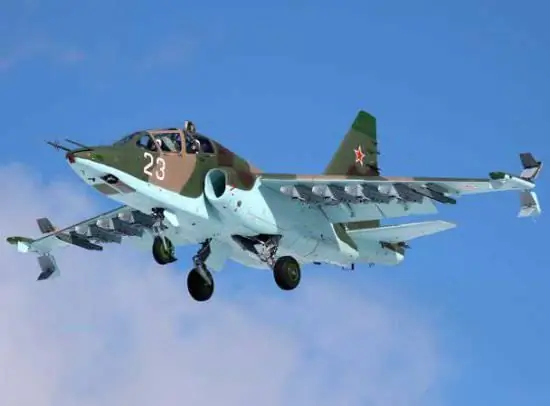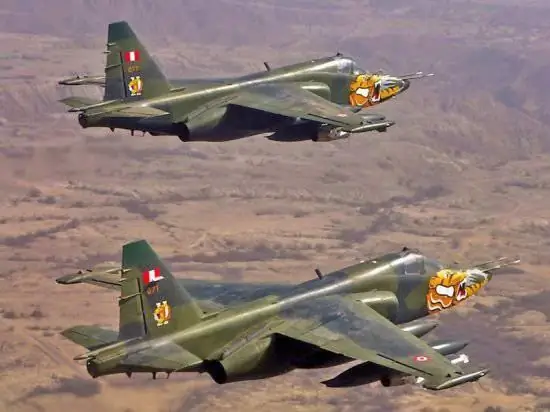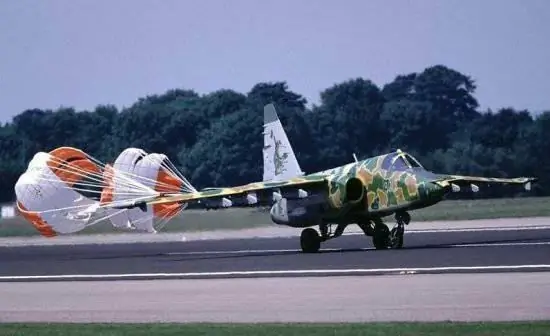- Author Matthew Elmers [email protected].
- Public 2023-12-16 21:49.
- Last modified 2025-01-24 09:17.

Ulan-Ude Aviation Plant is going to resume production of Su-25UB. Their construction was started in the last years of the existence of the USSR and stopped in the 90s, and now these aircraft can not only help the training of Air Force personnel, but also create the basis for the manufacture of new combat vehicles for ground attack aircraft.
At the aviation plant in Ulan-Ude, which is now part of the Russian Helicopters holding (main current profile: construction of Mi-171 helicopters, repair and modernization of Mi-8 rotorcraft), it is planned to re-launch the assembly of Su-25UB combat training attack aircraft in the interests of Russian Air Force. This was announced by the general director of the Oboronprom concern, Andrei Reus, noting that the issue of resuming production has been agreed with the United Aircraft Corporation. According to Reus, the car will receive more modern avionics. He also noted the high export potential of the Su-25 family aircraft, which have practically not been produced in series since the collapse of the Soviet Union.
Demanded car
Su-25 attack aircraft, which received the unofficial nickname "Rooks" in the army, are a good example of a cheap-to-operate and effective vehicle for direct support of ground forces. The development of a two-seat version of the aircraft, intended for full-scale combat use, began in the late 70s, but in connection with the preparation for the release of a new modification of the attack aircraft, the creation of a "flying simulator" was postponed, and in 1983 the construction of a prototype after two years of unhurried assembly and stopped altogether.
These delays led to the fact that the absence of combat training aircraft in combat units had to be compensated for actually by imports: all this time, the Soviet Air Force used two-seat L-39 Albatros of the Czechoslovak company Aero for training pilots of attack aircraft, which were purchased over 15 years by about 2000 units. As a result, the Su-25UB installation series at the Ulan-Ude plant began to be produced only in 1985.
In total, they managed to produce about three hundred cars.
In the export version (Su-25UBK), the aircraft in small quantities managed to get to Angola, Iraq, North Korea and Czechoslovakia following the delivery of basic Su-25K attack aircraft. Korean vehicles are assigned to the 55th Aviation Regiment, and, according to available information, they are maintained in a high degree of combat readiness, not least due to the simplicity and low cost of maintenance, as well as the availability of spare parts on the world arms market (including those in the gray »Parties). Nobody saw the Iraqi "rooks" after 2003 (it is believed that they could have been driven to Iran, as it already happened in 1991), while the Angolan ones, according to a number of information, are now unsuitable for active use. The Czechoslovakian ones are divided between the Czech and Slovak Air Forces. In 2000, the Czechs took all their Su-25 aircraft for storage, selling some of them to Georgia, and the Slovaks transferred their aircraft to Armenia. Some African countries also received combat training "drying" after the collapse of the USSR: some (Chad, Equatorial Guinea) - from Ukraine, others (Sudan and Cote d'Ivoire) - from Belarus.
Such a somewhat exotic geography of supplies shows how light combat training "rook", quite suitable not only for training flight personnel, but also for delivering full-fledged air strikes in low-intensity conflicts, is in demand in relatively poor third world countries - in primarily in Africa, on the "burning continent".
There was also a carrier-based version of a combat training attack aircraft (Su-25UTG), designed to practice the takeoff and landing skills of pilots of Su-27K fighters based on the heavy aircraft-carrying cruiser of project 1143.5 "Admiral Kuznetsov". At the moment, the naval aviation has no more than a dozen such training machines, and if a decision is made to build a new domestic aircraft carrier, their younger brothers, assembled in Ulan-Ude, with new radio electronics and a modernized control system, may well come into place.

Battle younger brother
It should be noted one important side aspect of the private, in essence, the decision to resume production of combat training "rooks". The fact is that the Su-25UB is approximately 85 percent unified in design with the Su-25T attack aircraft (they are also "humpbacked"), which were designed in the early 80s on the basis of training twin aircraft, subsequently "pushing aside" them in the priorities of the state defense order …
The Su-25T series of battlefield aircraft became a further development of the Su-25 concept, reoriented from "general-purpose" attack aircraft to narrow functions of fighting enemy armored vehicles. The new tank destroyer made its first flight in 1984, and began mass production only in 1990 at the Tbilisi aircraft plant, and therefore, before the collapse of the USSR, only 12 aircraft were built there, and the Russian Air Force, according to the results of the not very velvet divorce of the Union republics, got it, according to different data, no more than a dozen. These aircraft have been successfully used in Chechnya. It was also reported that about a dozen more Su-25Ts were assembled in Tbilisi between 1992 and 1996. However, it was not possible to find any traces of these attack aircraft in the Georgian Air Force, which, apparently, brings us back to the topic of illegal export of Soviet weapons to the third world.
In 1995, the first flight was made at the Ulan-Ude aircraft plant, the second modification of this family - the Su-25TM, the design of which began in 1984. Despite the official marking, this vehicle had only a layout relationship to its anti-tank predecessor, the "T" modification. Fundamental changes affected the avionics: in addition to upgrading the Shkval-M optoelectronic sighting system, the aircraft received an overhead Kopyo-25 fire control radar, as well as a GPS / GLONASS satellite navigation receiver. All this significantly expanded the attack capabilities of the attack aircraft.
The vehicle could now confidently use almost the entire range of airborne guided weapons, suitable for its weight and size characteristics. The arsenal of the aircraft included the Kh-31A and X-35 anti-ship missiles (an aviation analogue of the Uranium surface ship cruise missile complex), the Kh-31P and Kh-58 anti-radar missiles, the X-25 and Kh-29 families of attack missiles, and missiles laser-guided 9K121 "Whirlwind" and adjustable bombs. Air-to-air weapons were no exception: to the outdated R-60 melee thermal missiles, which were in the rooks' ammunition, more serious models were added - R-73 (short-range), R-27 and R- 77 (medium). Thus, the Su-25TM was able to stand up for itself in aerial combat, and some experts have already called it a "helicopter fighter".
As a result, from a highly specialized anti-tank aircraft, a completely new multi-purpose strike vehicle grew. That is why, in the interests of advertising, they began to abandon the TM marking, and since 1996 the export version of the Rook (Su-25TK) has been called the Su-39. However, full-scale serial production of new attack aircraft never began, although during the 2000s this issue was repeatedly considered. In particular, in October 2008, at an expanded meeting of the Ministry of Industry and Trade in Ulan-Ude, the task was set to resume production of the Su-25UB and Su-25TM from the moment the Ministry of Defense specifies its needs for these types of aircraft.

Backlog for the future
At the moment, apparently, we are talking about further specifying the application of the Russian Air Force for training combat vehicles. Last year, according to a number of sources, our military department intended to order 16 such attack aircraft, although this information was not officially confirmed. Taking into account the degree of unification of the production of modifications "UB" and "TM", it is quite possible to expect greater clarity in the issue of production and supply of combat "humpback" to the troops.
Ulan-Ude plant in this case will become a competitor for the state order to improve the fleet of ground attack aircraft of the Russian Air Force with the 121st aircraft repair plant in Kubinka near Moscow. It is there that work is now underway to modernize the basic Su-25 aircraft to the modification of the Su-25SM, which in its combat qualities competes with the Buryat attack aircraft (in particular, it uses a constructively built-in sighting system RLPK-25SM, created on the basis of the Kopyo-25 suspended radar ).
However, the 121st plant is not a full-fledged aircraft building enterprise and cannot produce new machines of the "SM" type, but is only able to improve the finished ones. In Soviet times, the head enterprise for the Su-25 was the already mentioned Tbilisi Aviation Plant, and at the enterprise in Ulan-Ude, which had previously produced MiG-27 fighter-bombers, was just being put on the Su-25UB line. In the early 90s, all the developments on the Su-25T were officially transferred there, after which they began to manufacture a modern version of the "TM" in the capital of Buryatia.
As a result, in 1992, Russia got the only aircraft factory equipped with the "25s", which is capable of building new attack aircraft, but it does not have the equipment for the production of a "standard" (and not a "hunchback") version of the "rook". And although the Ministry of Defense several times during the 2000s made statements that no new attack aircraft were planned to be supplied to the troops by 2020, now, in the light of the expansion of the state defense order, this position may be revised - if the Air Force decides that, in addition to the modernized version of the "SM" aviation also needs new attack aircraft.
As such, only the Su-25TM can be proposed, if we exclude the version of the competition for a new machine as an option that is too expensive in terms of time and resources, and the re-equipment of production in Ulan-Ude to the SM version is irrational for technological reasons and labor-intensive for administrative reasons. In this case, it seems that the resumption of the production of the Su-25UB in the Buryat capital will serve as a good "training" basis for the technological preparation of the potential serial production of new combat attack aircraft.






